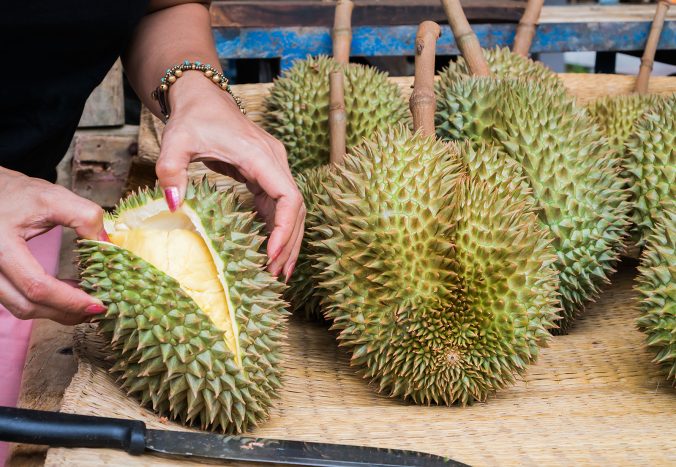Your breath will smell as if you’ve been French-kissing your dead grandmother.
Out in the Malaysian forest with forestry people beware if you happen upon a durian tree with ripe fruit. You are likely to be invited to try some as others watch on in a sort of forest initiation. It is really an invitation you can’t decline.
Durian (Durio zibethinus) trees are members of the hibiscus or mallow family, and are renowned for their large edible fruit. They are also related to breadfruit and jackfruit. Native to Indonesia and Malaysia, the durian is now cultivated in Indonesia, the Philippines, Malaysia, southern Thailand, southern India and north western Australia.
The durian tree grows to 45 metres tall in dense lowland forests with strong slender branches that grow almost horizontally from a straight central trunk. The tree has oblong tapering leaves, rounded at the base, and yellowish green flowers borne along the older branches. Named in some regions as the ‘King of Fruits’ the durian is internationally known for its love them or hate them fruit. They hang in clusters on thick stalks growing and ripening in just 14 weeks to the size of a rugby ball or bigger.
In the Malay language durian means thorn. Each fruit is defended by rough yellow-green semi wooden rind with sharp pyramid shape spines which cover it so completely that if the stalk happens to break off the fruit is it the times challenging to lift. The custard like pulp can be eaten at various stages of ripeness and is used in a variety of sweet and savory dishes. The seeds may also be roasted and eaten.
Some regard the durian as having a pleasantly sweet fragrance, whereas others find the aroma overpowering with an unpleasant odour. The smell evokes reactions from deep appreciation to intense disgust, and has been described variously as rotten onions, turpentine, and raw sewage. The persistence of its odour, which may linger for several days, has led certain hotels and public transportation services in Southeast Asia to put up signage advising people not to bring durian fruit inside.
The durian tree, a member of the hibiscus or mallow family, is renowned for its large edible fruit. Native to Indonesia and Malaysia, it is cultivated in Indonesia, the Philippines, Malaysia, southern Thailand, southern India and north western Australia.
When ripe the fruit splits to reveal white, slightly fibrous pith in which four or five large custard yellow segments are embedded in each containing a few large seeds. The fruit is notorious for its strong smell which attracts large mammals, such as wild boar and monkeys who can disperse the fruit and seeds far from the mother tree. Elephants will wait patiently for durian to fall when they devour the fruit, swallowing some seeds and depositing them at considerable distances together with a handy pile of fertiliser.
It’s flavour and fragrance can provoke strong feelings. The English writer Anthony Burgess liken the experience to “… eating sweet raspberry blancmange in the lavatory”, and the American chef and broadcaster Anthony Bourdain has been widely quoted as saying: “Your breath will smell as if you’ve been French-kissing your dead grandmother.”
Durian timber is popular with grain variations from straight to interlocked. Texture is coarse and often uneven. The heartwood is pink brown, grey brown, brown with red tinge or light orange brow. Grain is straight to slightly interlocked. The sapwood is lighter coloured and distinct.
Durian timber is used in light construction, plywood, furniture, window and door manufacturing, and other joinery, panelling and veneer.
